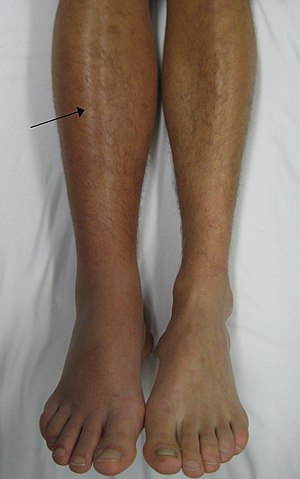 Image via Wikipedia How to avoid Deep Vein Thrombosis...
Image via Wikipedia How to avoid Deep Vein Thrombosis... ..
OPINION: First published on Fortitude
by peter petterson
You may or may not have heard that flying for four hours or more in cramped conditions puts you at risk of getting Deep Vein Thrombosis or DVT. However, even sitting for long periods at home or at the office in front of your computer can affect you the same way.
What then is Deep Vein Thrombosis, you may ask? DVT occurs when a blood clot forms in your legs and blocks normal blood flow. The real deep vein thrombosis (DVT)
Arteries have thin muscles within their walls to be able to withstand the pressure of the heart pumping blood to the far reaches of the body. Veins don't have a significant muscle lining, and there is nothing pumping blood back to the heart except physiology. Blood returns to the heart because the body's large muscles squeeze the veins as they contract in their normal activity of moving the body. The normal activities of moving the body returns the blood back to the heart.
There are two types of veins in the leg; superficial veins and deep veins. Superficial veins lie just below the skin and are easily seen on the surface. Deep veins, as their name implies, are located deep within the muscles of the leg. Blood flows from the superficial veins into the deep venous system through small perforator veins. Superficial and perforator veins have one-way valves within them that allow blood to flow only in the direction of the heart when the veins are squeezed.
A blood clot (thrombus) in the deep venous system of the leg is not dangerous in itself. The situation becomes life-threatening when a piece of the blood clot breaks off (embolus, pleural=emboli), travels downstream through the heart into the pulmonary circulation system, and becomes lodged in the lung. Diagnosis and treatment of a deep venous thrombosis (DVT) is meant to prevent pulmonary embolism.
Clots in the superficial veins do not pose a danger of causing pulmonary emboli because the perforator vein valves act as a sieve to prevent clots from entering the deep venous system. They are usually not at risk of causing pulmonary embolismanger though is that the clot will break off and travel to your heart or lungs where it can have some serious consequences.
These clots can form through a lack of movement, so if you are inactive for very long periods get up and move around, at least once an hour to get the blood flowing again regularly.
Down here in New Zealand there is the local brand of Flight Socks that are reportedly medically proven to help with the prevention of DVT. Scholes have a long history here NZ in supplying a variety of foot treatments. However these foot socks are not only useful on long haul air flights, but on other long trips in the car, bus or train or whe reever you are sitting in cramped conditions.
They reportedly have a graduated compression system to help improve blood flow and ease other problems such as tired,aching legs.
These socks come as black knee-high socks, sheer denier black and Silky Black. The latter is made from new yarn technology that's even more comfortabler to put on. So there's something for everybody. They are readily available fro most pharmacies and don't require professional fitting.
DVT PREVENTION TIPS:
1/ Pull on a pair of Scholes Flight Socks when sitting for long periods.
2/ Use a footrest if your feet don't touch the floor.
3/ Keep legs uncrossed to reduce pressure on lower legs.
4/ Do little foot exercises such as rotating and pointing your foot. This will help contract and relax the calf and ankle muscles.
Other contributing factors:
Other factors can contribute to the development of DVT. If you have had a previous history of clotting disorders or suffer from certain medical conditions like diabetes, cancer,arterial problems, leg ulcers or heart diseasee or are on contraceptives, you should seek qualified healthcare advice.
Acknowledgements: Peter Petterson

No comments:
Post a Comment